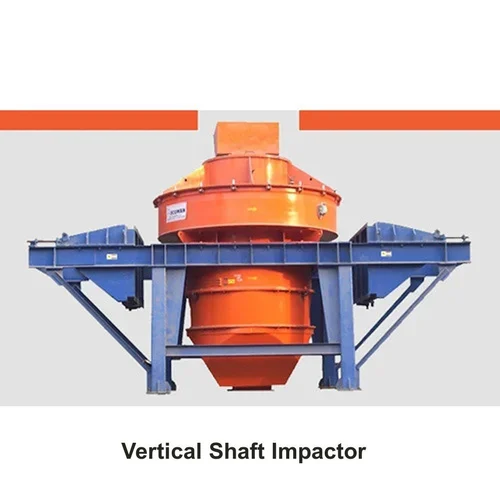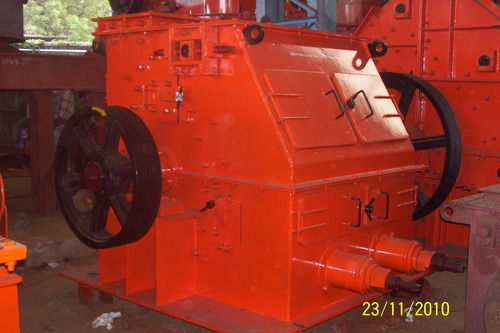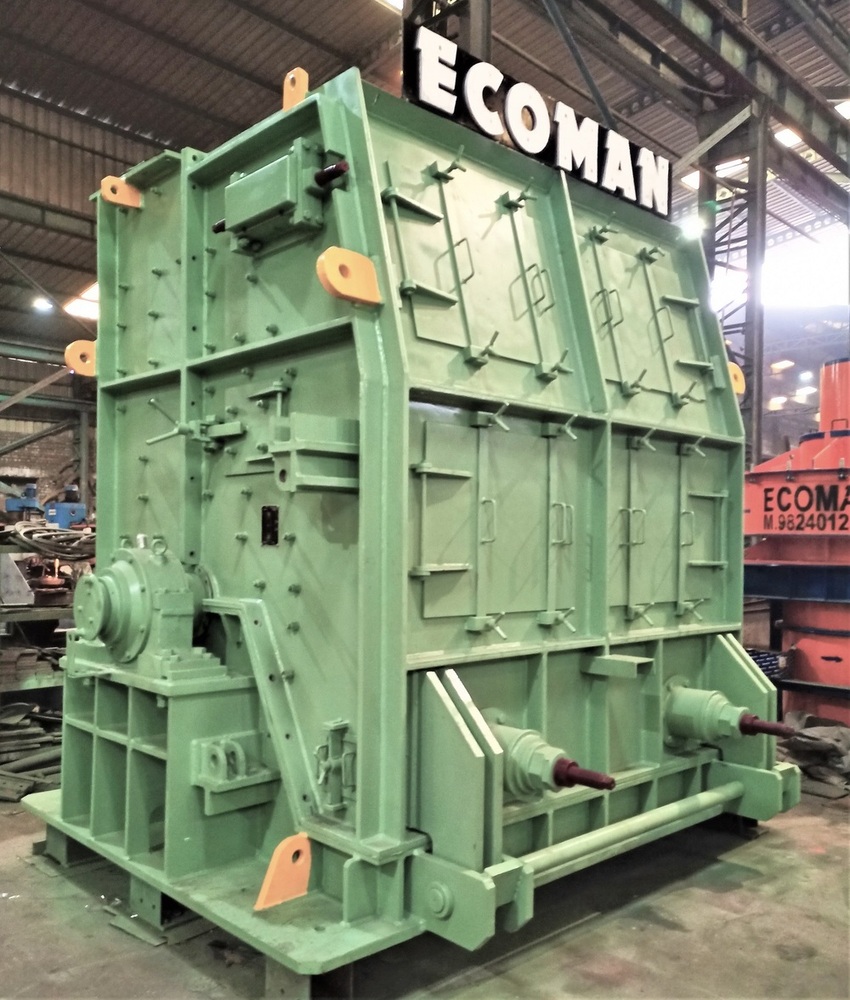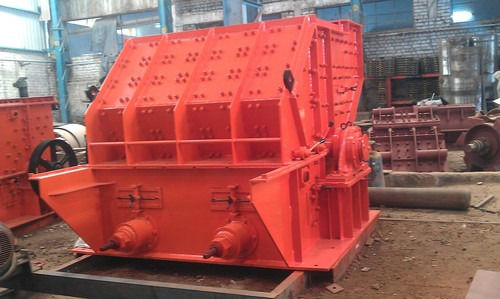


Vertical Shaft Impactor
Product Details:
- Product Type Vertical Impactor
- General Use Industrial
- Material Steel
- Capacity 250 T/hr
- Automatic Yes
- Voltage 380 Volt (v)
- Color Orange
- Click to view more
Vertical Shaft Impactor Price And Quantity
- 1 Unit
- 1300000 INR
Vertical Shaft Impactor Product Specifications
- Industrial
- 380 Volt (v)
- Orange
- Yes
- 1 Year
- Vertical Impactor
- 250 T/hr
- Steel
Vertical Shaft Impactor Trade Information
- Cash in Advance (CID), Cheque, Cash Advance (CA), Letter of Credit (L/C)
- 1 Unit Per Month
- 7-8 Months
- No
- Central America, Western Europe, Asia, Eastern Europe, Middle East, Africa, Australia, North America, South America
- All India
- ISO
Product Description
Vertical Shaft Impactor is a highly strong machine, which provides well-organized functionality and boast of high compatibility. The machine is widely appreciated for its extended functional life, robust construction and simple operation.
Vertical Shaft Impactor works similar to a Centrifugal machine, in which stones get fed into rotor center and it gets thrown outwards towards the boundary through the process of outward-emerging force. The feed material owing to the centrifugal power gets its advanced speed. The feed particles have high kinetic energy which work against the pressures of breaking surfaces produced within the particles. The resultant materials are of optimum strength. The machine is better than the traditional Impact Crushers in different ways.
We manufacture the shaft impactor in two types; Stone on Stone type and Stone on Steel type.
Vertical Shaft Impactor Benefits
- Machine is both versatile and efficient.
- The ability to crush both hard and fragile materials.
- Cement clinker, rock, grinding material, refractory material, and concrete aggregate are all ideal for handling.
- Suitable for construction and road-making purposes.
Crusher Dimensions in mm
|
TYPE |
A |
B |
C |
D |
E |
F |
G |
|
35 |
1630 |
900 |
791 |
300/594 |
1104 |
1600 |
3400 |
|
55 |
1866 |
1643 |
798 |
500 |
1690 |
2600 |
4550 |
|
80 |
1866 |
1643 |
798 |
500 |
1690 |
2600 |
4550 |
|
110/160 |
2484 |
1659 |
978.5 |
-0 |
-0 |
2800 |
4170 |
|
220/330 |
3005 |
2439 |
1178 |
606 |
2006 |
-0 |
-0 |
Crusher data
|
TYPE |
35 |
55 |
80 |
110 |
160 |
220 |
330 |
|
|
Max. Feed size |
0-30 |
0-35 |
0-35 |
0-40 |
0-40 |
0-50 |
0-50 |
|
|
R |
Diameter in mm |
610 |
780 |
780 |
1000 |
1000 |
1200 |
1200 |
|
Surface speed m/sec |
30-62 |
45-65 |
45-65 |
45-65 |
45-65 |
35-55 |
35-55 |
|
|
RPM |
1300-2000 |
1320-2000 |
1320-2000 |
1030-1670 |
1030-1490 |
640-990 |
640-990 |
|
|
Power in KW |
55 |
75 |
90 |
160 |
200 |
250 |
300 |
|
|
V-Belts |
4xXPB |
5xSPC |
6xSPC |
6xSPC |
6xSPC |
8xSPC |
8xSPC |
|
|
Wt. in Kgs. approx |
2800 |
3200 |
3800 |
5800 |
6000 |
6900 |
7000 |
|
|
Motor Pulley |
236 |
250 |
265 |
4000 |
400 |
540 |
540 |
|
Production Capacities (depend on material & feed size, approx values)
|
Type |
Through Put |
Product Through Put |
|
|
0-2 mm |
0-4 mm |
||
|
35 |
40 tph |
8-12 tph |
15-20 tph |
|
55 |
70 tph |
12-16 tph |
20-25 tph |
|
80 |
90 tph |
16-24 tph |
23-30 tph |
|
110 |
130 tph |
25-30 tph |
35-40 tph |
|
160 |
160 tph |
30-40 tph |
50-70 tph |
|
220 |
220 tph |
50-70 tph |
70-90 tph |
|
330 |
280 tph |
70-90 tph |
110-130 tph |
Closed Rotor (Welded Construction)
- Hard facing (Rebuilding)
- Main Body
- Material Build up
- Wear Components
Open Rotor (Bolted Construction)
- Main Body
- Wear Components
Product - 0-4
|
Mineral |
Hre Apprx. |
|
Mineral with 15%Quartz |
1500-1300 |
|
Mineral with 60-90% Quartz |
500-1500 |
|
Klinker |
4000-8000 |
|
Granite/Basalt |
1000-7000 |
|
Limestone |
4000-12000 |
|
Corundum |
250-500 |
|
Blast Furnace Slog |
3000-4000 |
|
Bauxite |
500-1000 |
- Above Non-binding values differentiate considerably.
- Payment Term : 40% Advance, Balance against Proforma invoice
Download Brochure
Vertical Shaft Impactor FAQs
What is the working principle of vertical shaft impactor?
In a VSI machine, the material is enhanced via centrifugal force made by the rotor against the outer anvil ring. Afterwards, the machines can break down the coals and gavels with high momentum.
How much effect is VSI Crushing Method?
The machines get operated with a primary or secondary crusher. It is totally ideal for making sand, coarse and medium aggregates for efficient production of concrete/asphalt.

Price:
- 50
- 100
- 200
- 250
- 500
- 1000+







 English
English Spanish
Spanish French
French German
German Italian
Italian Chinese (Simplified)
Chinese (Simplified) Japanese
Japanese Korean
Korean Arabic
Arabic Portuguese
Portuguese